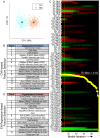Plasticity in the macromolecular-scale causal networks of cell migration
- PMID: 24587399
- PMCID: PMC3938764
- DOI: 10.1371/journal.pone.0090593
Plasticity in the macromolecular-scale causal networks of cell migration
Abstract
Heterogeneous and dynamic single cell migration behaviours arise from a complex multi-scale signalling network comprising both molecular components and macromolecular modules, among which cell-matrix adhesions and F-actin directly mediate migration. To date, the global wiring architecture characterizing this network remains poorly defined. It is also unclear whether such a wiring pattern may be stable and generalizable to different conditions, or plastic and context dependent. Here, synchronous imaging-based quantification of migration system organization, represented by 87 morphological and dynamic macromolecular module features, and migration system behaviour, i.e., migration speed, facilitated Granger causality analysis. We thereby leveraged natural cellular heterogeneity to begin mapping the directionally specific causal wiring between organizational and behavioural features of the cell migration system. This represents an important advance on commonly used correlative analyses that do not resolve causal directionality. We identified organizational features such as adhesion stability and adhesion F-actin content that, as anticipated, causally influenced cell migration speed. Strikingly, we also found that cell speed can exert causal influence over organizational features, including cell shape and adhesion complex location, thus revealing causality in directions contradictory to previous expectations. Importantly, by comparing unperturbed and signalling-modulated cells, we provide proof-of-principle that causal interaction patterns are in fact plastic and context dependent, rather than stable and generalizable.
Conflict of interest statement
Figures






Similar articles
-
Disentangling Membrane Dynamics and Cell Migration; Differential Influences of F-actin and Cell-Matrix Adhesions.PLoS One. 2015 Aug 6;10(8):e0135204. doi: 10.1371/journal.pone.0135204. eCollection 2015. PLoS One. 2015. PMID: 26248038 Free PMC article.
-
Paxillin phosphorylation at Ser273 localizes a GIT1-PIX-PAK complex and regulates adhesion and protrusion dynamics.J Cell Biol. 2006 May 22;173(4):587-9. doi: 10.1083/jcb.200509075. J Cell Biol. 2006. PMID: 16717130 Free PMC article.
-
Focal adhesion kinase and paxillin promote migration and adhesion to fibronectin by swine skeletal muscle satellite cells.Oncotarget. 2016 May 24;7(21):30845-54. doi: 10.18632/oncotarget.9010. Oncotarget. 2016. PMID: 27127174 Free PMC article.
-
Integrins in cell migration--the actin connection.J Cell Sci. 2009 Jan 15;122(Pt 2):199-206. doi: 10.1242/jcs.018564. J Cell Sci. 2009. PMID: 19118212 Free PMC article. Review.
-
Microtubules in cell migration.Essays Biochem. 2019 Oct 31;63(5):509-520. doi: 10.1042/EBC20190016. Essays Biochem. 2019. PMID: 31358621 Free PMC article. Review.
Cited by
-
Using Systems Microscopy to Understand the Emergence of Cell Migration from Cell Organization.Methods Mol Biol. 2018;1749:119-134. doi: 10.1007/978-1-4939-7701-7_10. Methods Mol Biol. 2018. PMID: 29525994
-
Time series modeling of live-cell shape dynamics for image-based phenotypic profiling.Integr Biol (Camb). 2016 Jan;8(1):73-90. doi: 10.1039/c5ib00283d. Epub 2015 Dec 11. Integr Biol (Camb). 2016. PMID: 26658688 Free PMC article.
-
Neuronal Growth Cone Size-Dependent and -Independent Parameters of Microtubule Polymerization.Front Cell Neurosci. 2018 Jul 17;12:195. doi: 10.3389/fncel.2018.00195. eCollection 2018. Front Cell Neurosci. 2018. PMID: 30065631 Free PMC article.
-
Community standards for open cell migration data.Gigascience. 2020 May 1;9(5):giaa041. doi: 10.1093/gigascience/giaa041. Gigascience. 2020. PMID: 32396199 Free PMC article.
-
EZH2 promotes neoplastic transformation through VAV interaction-dependent extranuclear mechanisms.Oncogene. 2018 Jan 25;37(4):461-477. doi: 10.1038/onc.2017.309. Epub 2017 Oct 2. Oncogene. 2018. PMID: 28967906
References
-
- Horwitz R, Webb D (2003) Cell migration. Curr Biol 13: R756–R759. - PubMed
Publication types
MeSH terms
Substances
LinkOut - more resources
Full Text Sources
Other Literature Sources

